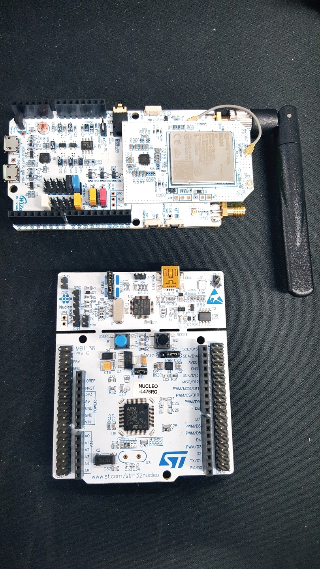BG96 Cat.M1 basic sample for WIZnet IoT Shield based on Mbed-OS Cellular APIs (SK telecom network in Korea)
Overview
This code could be access via Cat.M1(BG96 module) of SK telecom network in Korea. Need a WIZnet IoT Shield BG96 board and development board. The code forked Daniel_Lee's mbed-os-example-cellular-BG96 repository and added some features.


Tested with
- NUCLEO_L476RG
- DISCO_L475VG_IOT01A
- K64F
Example functionality
This example showcases the following device functionality:
1. Import the application into your desktop:
mbed import https://os.mbed.com/users/hkjung/code/mbed-os-example-cellular-BG96/ cd mbed-os-example-cellular-BG96
2. Compile and program:
mbed compile -t <toolchain> -m <TARGET_BOARD>
(supported toolchains : GCC_ARM / ARM / IAR)
3. Download binary to a target board
If need more information such as how to test, please look at https://os.mbed.com/teams/mbed-os-examples/code/mbed-os-example-cellular/.
README.md
- Committer:
- mbed_official
- Date:
- 2018-03-09
- Revision:
- 2:0f644d6045cf
- Parent:
- 0:4611f6cf2413
- Child:
- 6:5678c0b6f74e
File content as of revision 2:0f644d6045cf:
# Example cellular application for Mbed OS
This is an example based on `mbed-os` cellular APIs that demonstrates a TCP or UDP echo transaction with a public echo server.
## Getting started
This particular cellular application uses a cellular network and network-socket APIs that are part of [`mbed-os`](https://github.com/ARMmbed/mbed-os).
The program uses a [generic cellular modem driver](https://github.com/ARMmbed/mbed-os/tree/master/features/netsocket/cellular/generic_modem_driver) using an external IP stack (LWIP) standard 3GPP AT 27.007 AT commands to setup the cellular modem and registers to the network.
After registration, the driver opens a point-to-point protocol (PPP) pipe using LWIP with the cellular modem and connects to internet. This driver currently supports UART data connection type only between your cellular modem and MCU.
For more information on Arm Mbed OS cellular APIs and porting guide, please visit the [Mbed OS cellular API](https://os.mbed.com/docs/latest/reference/cellular-api.html) and [contributing documentation](https://os.mbed.com/docs/latest/reference/contributing-connectivity.html#cellularinterface).
### Download the application
```sh
$ mbed import mbed-os-example-cellular
$ cd mbed-os-example-cellular
#OR
$ git clone git@github.com:ARMmbed/mbed-os-example-cellular.git
$ cd mbed-os-example-cellular
```
### Change the network and SIM credentials
See the file `mbed_app.json` in the root directory of your application. This file contains all the user specific configurations your application needs. Provide the pin code for your SIM card, as well as any APN settings if needed. For example:
```json
"sim-pin-code": {
"help": "SIM PIN code",
"value": "\"1234\""
},
"apn": {
"help": "The APN string to use for this SIM/network, set to 0 if none",
"value": "\"internet\""
},
"username": {
"help": "The user name string to use for this APN, set to zero if none",
"value": 0
},
"password": {
"help": "The password string to use for this APN, set to 0 if none",
"value": 0
}
```
### Selecting socket type (TCP or UDP)
You can choose which socket type the application should use; however, please note that TCP is a more reliable tranmission protocol. For example:
```json
"sock-type": "TCP",
```
### Turning modem AT echo trace on
If you like details and wish to know about all the AT interactions between the modem and your driver, turn on the modem AT echo trace. Set the `modem_trace` field value to be true.
```json
"modem_trace": {
"help": "Turns AT command trace on/off from the cellular modem, defaults to off",
"value": true
},
```
### Board support
The [generic cellular modem driver](https://github.com/ARMmbed/mbed-os/tree/master/features/netsocket/cellular/generic_modem_driver) this application uses was written using only a standard AT command set. It uses PPP with an Mbed-supported external IP stack. These abilities make the driver essentially generic, or nonvendor specific. However, this particular driver is for onboard-modem types. In other words, the modem exists on the Mbed Enabled target as opposed to plug-in modules (shields). For more details, please see our [Mbed OS cellular documentation](https://os.mbed.com/docs/latest/reference/cellular-api.html).
Examples of Mbed Enabled boards with onboard modem chips include [u-blox C027](https://os.mbed.com/platforms/u-blox-C027/) and [MultiTech MTS Dragonfly](https://os.mbed.com/platforms/MTS-Dragonfly/).
## Compiling the application
Use Mbed CLI commands to generate a binary for the application. For example, in the case of GCC, use the following command:
```sh
$ mbed compile -m YOUR_TARGET_WITH_MODEM -t GCC_ARM
```
## Running the application
Drag and drop the application binary from `BUILD/YOUR_TARGET_WITH_MODEM/GCC_ARM/mbed-os-example-cellular.bin` to your Mbed Enabled target hardware, which appears as a USB device on your host machine.
Attach a serial console emulator of your choice (for example, PuTTY, Minicom or screen) to your USB device. Set the baudrate to 115200 bit/s, and reset your board by pressing the reset button.
You should see an output similar to this:
```
mbed-os-example-cellular
Establishing connection ......
Connection Established.
TCP: connected with echo.mbedcloudtesting.com server
TCP: Sent 4 Bytes to echo.mbedcloudtesting.com
Received from echo server 4 Bytes
Success. Exiting
```
## Troubleshooting
If you have problems, you can review the [documentation](https://os.mbed.com/docs/latest/tutorials/debugging.html) for suggestions on what could be wrong and how to fix it.
 Eric Jung
Eric Jung